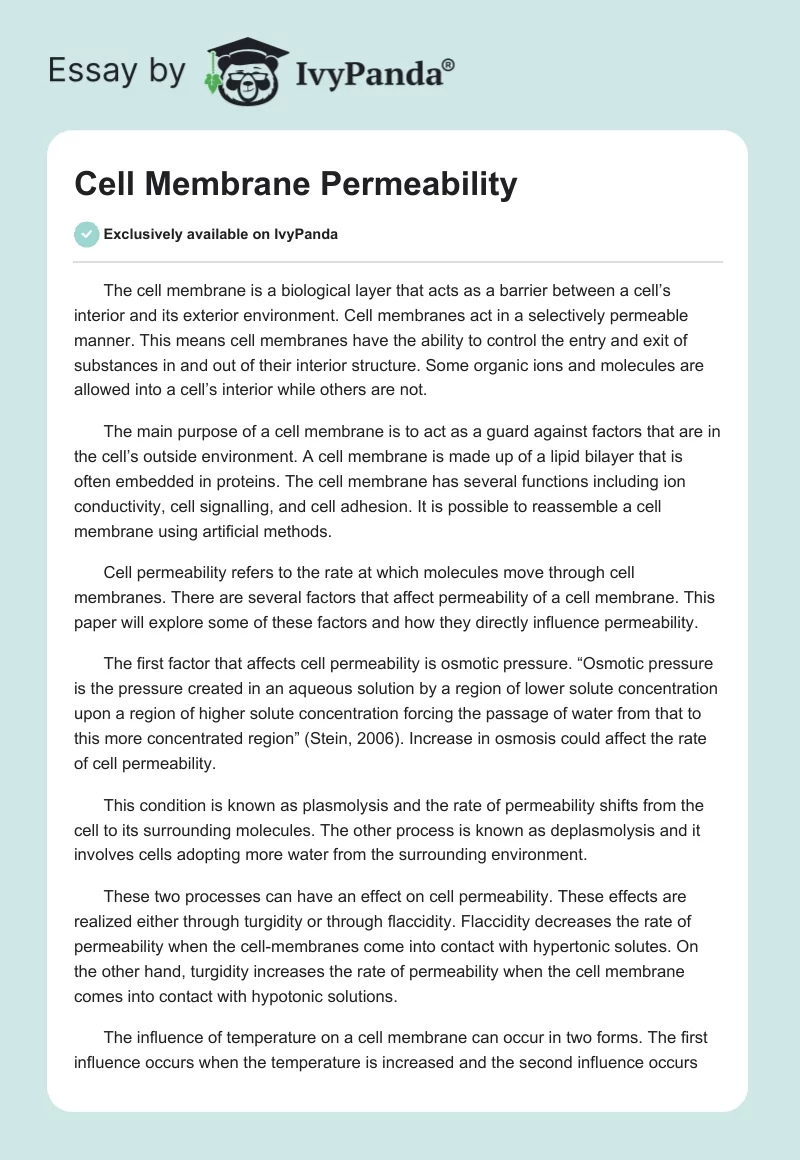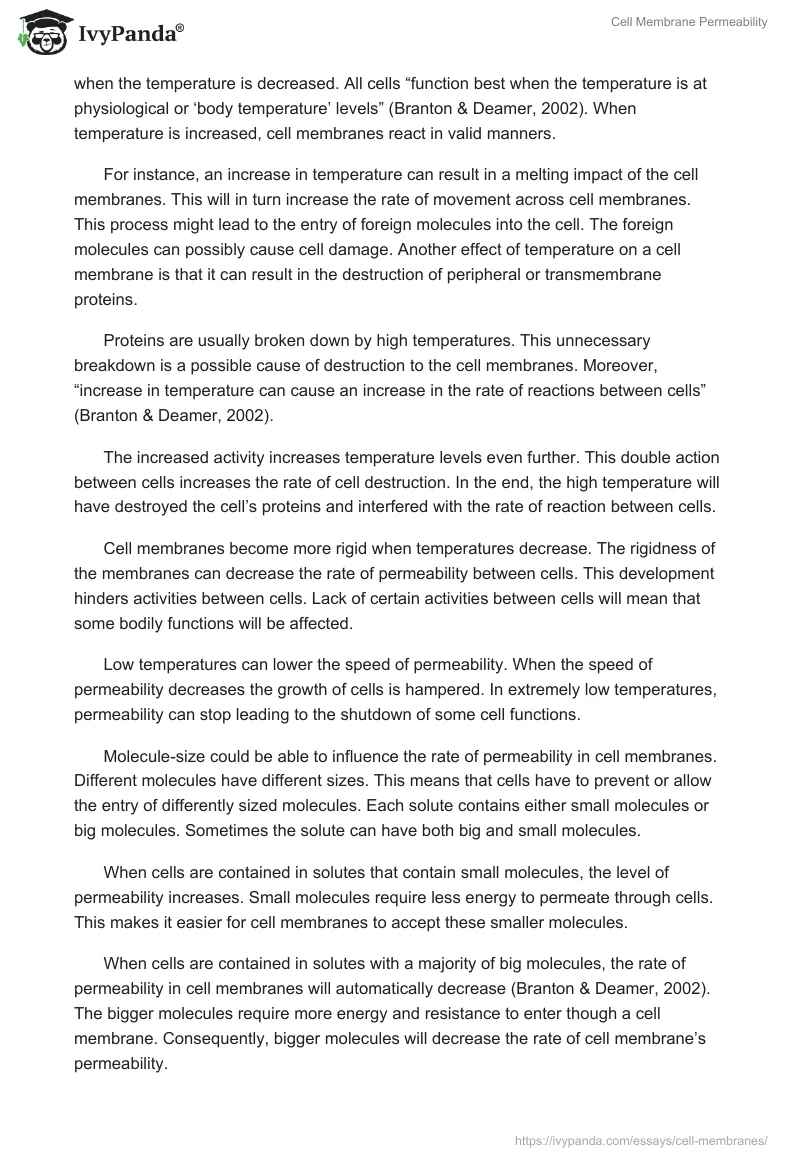The cell membrane is a biological layer that acts as a barrier between a cell’s interior and its exterior environment. Cell membranes act in a selectively permeable manner. This means cell membranes have the ability to control the entry and exit of substances in and out of their interior structure. Some organic ions and molecules are allowed into a cell’s interior while others are not.
The main purpose of a cell membrane is to act as a guard against factors that are in the cell’s outside environment. A cell membrane is made up of a lipid bilayer that is often embedded in proteins. The cell membrane has several functions including ion conductivity, cell signalling, and cell adhesion. It is possible to reassemble a cell membrane using artificial methods.
Cell permeability refers to the rate at which molecules move through cell membranes. There are several factors that affect permeability of a cell membrane. This paper will explore some of these factors and how they directly influence permeability.
The first factor that affects cell permeability is osmotic pressure. “Osmotic pressure is the pressure created in an aqueous solution by a region of lower solute concentration upon a region of higher solute concentration forcing the passage of water from that to this more concentrated region” (Stein, 2006). Increase in osmosis could affect the rate of cell permeability.
This condition is known as plasmolysis and the rate of permeability shifts from the cell to its surrounding molecules. The other process is known as deplasmolysis and it involves cells adopting more water from the surrounding environment.
These two processes can have an effect on cell permeability. These effects are realized either through turgidity or through flaccidity. Flaccidity decreases the rate of permeability when the cell-membranes come into contact with hypertonic solutes. On the other hand, turgidity increases the rate of permeability when the cell membrane comes into contact with hypotonic solutions.
The influence of temperature on a cell membrane can occur in two forms. The first influence occurs when the temperature is increased and the second influence occurs when the temperature is decreased. All cells “function best when the temperature is at physiological or ‘body temperature’ levels” (Branton & Deamer, 2002). When temperature is increased, cell membranes react in valid manners.
For instance, an increase in temperature can result in a melting impact of the cell membranes. This will in turn increase the rate of movement across cell membranes. This process might lead to the entry of foreign molecules into the cell. The foreign molecules can possibly cause cell damage. Another effect of temperature on a cell membrane is that it can result in the destruction of peripheral or transmembrane proteins.
Proteins are usually broken down by high temperatures. This unnecessary breakdown is a possible cause of destruction to the cell membranes. Moreover, “increase in temperature can cause an increase in the rate of reactions between cells” (Branton & Deamer, 2002).
The increased activity increases temperature levels even further. This double action between cells increases the rate of cell destruction. In the end, the high temperature will have destroyed the cell’s proteins and interfered with the rate of reaction between cells.
Cell membranes become more rigid when temperatures decrease. The rigidness of the membranes can decrease the rate of permeability between cells. This development hinders activities between cells. Lack of certain activities between cells will mean that some bodily functions will be affected.
Low temperatures can lower the speed of permeability. When the speed of permeability decreases the growth of cells is hampered. In extremely low temperatures, permeability can stop leading to the shutdown of some cell functions.
Molecule-size could be able to influence the rate of permeability in cell membranes. Different molecules have different sizes. This means that cells have to prevent or allow the entry of differently sized molecules. Each solute contains either small molecules or big molecules. Sometimes the solute can have both big and small molecules.
When cells are contained in solutes that contain small molecules, the level of permeability increases. Small molecules require less energy to permeate through cells. This makes it easier for cell membranes to accept these smaller molecules.
When cells are contained in solutes with a majority of big molecules, the rate of permeability in cell membranes will automatically decrease (Branton & Deamer, 2002). The bigger molecules require more energy and resistance to enter though a cell membrane. Consequently, bigger molecules will decrease the rate of cell membrane’s permeability.
The PH level of the solute that contains cells also affects a cell membrane’s permeability. Different solutes contain different levels PH levels and this translates to different permeability levels. Solutes that contain high PH levels increase the levels of activity within the cell membrane.
High PH levels also lead to an increase in temperatures within the cell membranes. When the PH levels are too high, the cell membranes can be destroyed. On the other hand, low PH levels can foster a healthy rate of cell permeability. However, very low PH levels can hamper permeability of the cell membranes.
References
Branton, D & Deamer, D 2002, Membrane structure, Springer Vienna, London.
Stein, W 2006, Transport and diffusion across cell membranes, Academic Press, New York.


